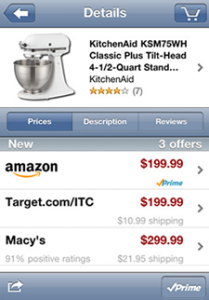It’s fun, high-touch, sensual and social. You can’t squeeze a melon online, or try on that shirt to see how the color complements your skin tone. People watching is fun in the mall, not so much on eBay.
Retailers won’t be going away anytime soon. Most people think online sales are much higher, but the Commerce Department reported that E-commerce accounted for just 5.2 percent of total retail sales in 2012.
Still, retailers are under assault. The transparency of the Internet gives consumers unprecedented power. My iPhone tells me on the spot if I’m getting the best price. I can then vote with my feet and buy the item at another retailer or simply go online and have it shipped to my home.
This trend toward “showrooming,” checking out merchandise in a store and then buying it at a better price elsewhere or online, has put retailers between a rock and a hard place.
As reported in Salon this week, some are trying to solve this problem by charging customers to browse or try on merchandise. Good luck with that.
Others have tried the home delivery route, allowing customers to order groceries or other goods from locally based businesses online, saving them a trip to the store. This never really caught on, but the expectation is clearly that it eventually will. A post on Engadet announced Google’s pilot of their Shopping Express service in San Francisco, offering “same-day delivery from Target, Walgreens, Toys R Us, American Eagle, Staples, Office Depot and a few local shops. Amazon and eBay are already testing similar services.”
While these services are still selling merchandise from established, branded retailers, loyalty to those retailers will likely erode over time. The lesson of showrooming is that consumers don’t care where they get the products they want, as long as they get them as inexpensively and conveniently as possible.
The flip side of this trend is reflected on a Tech Crunch post which cites a February 2013 report on iPhone sales. They identified a “try before buy trend,” based on the fact that 71% of sales generated by iPhones come from In-App Purchases.
This means “that the app itself was free, but other features, virtual goods, extra levels, services, upgrades, and more are available for sale once the app is on the iPhone.”
So we have people entering the “store” (app) and staying to buy when they are on mobile devices, but in brick and mortar establishments, they come in and leave the store to make the purchase somewhere else. While not quite apples and apples, the comparison is very telling and does not bode well for traditional retailers.
So should we round up the usual suspects and brainstorm how we can “elevate the in-store experience and better differentiate our brand?” Probably not. The message to the overwhelming majority of major retailers is clear. We may care about the brands we buy, but we sure don’t care about your brand. Maybe they would if quality and service improved dramatically while prices stayed at the same level or were cut, but that’s not a sustainable strategy.
Some real innovation needs to happen.
Here’s an interesting idea reported by Venture Beat. Wal-Mart has developed a plan based on crowdsourcing and the “idea of the “sharing economy,” which connects people with available goods, services, skills, space, time, etc….to those who need them. (Wal-Mart) would pay in-store customers to deliver online orders to people in their community. People who are shopping at an actual Wal-Mart can sign up to drop off packages for people who live nearby, and in exchange receive a discount on their shipping bill.
It’s anyone’s guess whether or not this will work, but at least it’s some out-of-the-big-box-store thinking.




